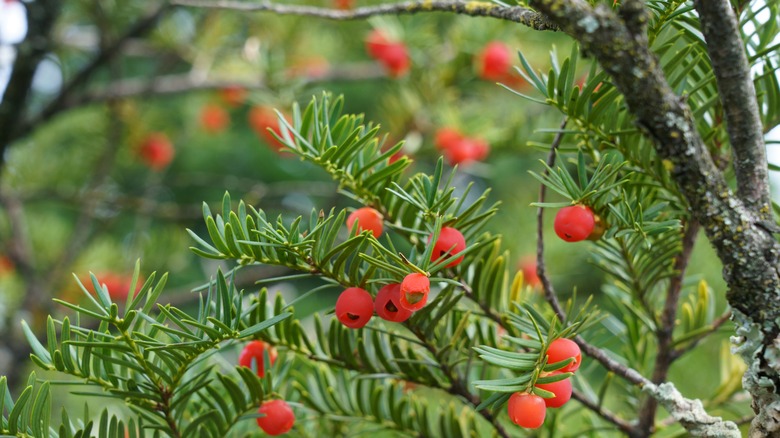Dog Owners Might Want To Rethink Planting This Species Of Yew Tree In Their Yards
Enhanced privacy, lovely cool shade in summer, and improved air quality are some very good reasons why you might want to plant a yew tree in your backyard. These lovely trees can be pruned into hedges and are relatively low maintenance, but if you're a dog owner, you might want to rethink your choices. In particular, Japanese yews (Taxus cuspidata) are extremely toxic to dogs and can be fatal if any part of the tree, including the leaf, stem, bark, root, and seed, is ingested. These trees are also toxic to humans and other animals. The only part of the entire tree that's not toxic is the fleshy portion of the red berries, but the seeds inside the berries are extremely poisonous.
Along with the Japanese yew, the common or English yew (Taxus baccata) is also toxic not only to dogs but also to humans. While the Japanese yew and the English yew are the most toxic, even the American yew (Taxus canadensis) and the Western yew (Taxus brevifolia) contain dangerous toxins. Yew trees are also toxic to livestock, including horses and cattle, in relatively small doses, and there's no effective treatment once the animal has been poisoned. However, it's recommended that supportive therapy be implemented and that the use of Atropine sulfate can counteract the slow heart rate.
What makes yews so dangerous to dogs and other animals?
Yew trees contain toxic alkaloids known as taxine A and taxine B. These toxins negatively affect the gastrointestinal, cardiovascular, respiratory, nervous, and musculoskeletal systems of the body in dogs, livestock, and humans. While yew trees are poisonous all year round, in winter, the leaves have the highest concentration of these taxines. Even when dried, all parts of the plant, except for the flesh of the berry, are still highly toxic. This is particularly important to remember if the branches are used to make Christmas wreaths, which is quite popular.
It's been noted that death can be quite sudden once any part of the tree has been ingested, often without any other major symptoms. Death can happen in only one to three hours after ingestion. But, if only a small portion has been consumed, then symptoms could include vomiting, diarrhea, slowing of the heart rate, difficulty breathing, muscle trembling, and convulsions. So, if you have a dog or cat, you might want to avoid planting a yew tree or shrub in your garden. Another red berry shrub you might not want in your garden if you have pets is the rockspray cotoneaster.
What should you do if you have a yew tree growing in your yard?
If you do happen to have a yew growing in your yard, you just need to be aware of its toxicity and make sure that you keep pets and children well away from the tree. You also want to make sure that the tree is not accessible to livestock if you're in a more rural region. While it may be tempting, you'll need to avoid using the plant in Christmas decorations that you're going to display inside your home.
If you're growing a yew hedge in your garden, it will require regular trimming. It's a good idea to wear gloves when pruning this or at least wash your hands well after pruning, especially if you're going to be handling food afterward. Dispose of the trimmings safely. Never be tempted to throw these over the fence as fodder for neighboring livestock, as the results could be lethal. Clean and disinfect your tools after handling these plants, as this removes any residue.
If you're looking for some non-toxic alternatives to plant in your garden instead of the popular yew, you could consider the Japanese false-cypress (Chamaecyparis pisifera). This plant is drought-tolerant, and there are different forms available with interesting shapes. It's one of the best hedges you can plant for privacy in your yard. Other species you might want to consider are the dwarf Hinoki cypress (Chamaecyparis obtusa 'Nana Gracilis') or the dwarf Alberta spruce (Picea glauca 'Conica').


